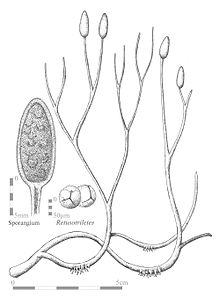Aglaophyton
|
Aglaophyton Temporal range: Early Devonian |
|
|---|---|
 |
|
| Reconstruction of the sporophyte of Aglaophyton, illustrating bifurcating axes with terminal sporangia, and rhizoids. Insets show a cross-section of a sporangium and the probable spores. | |
| Scientific classification | |
| Kingdom: | Plantae |
| Clade: | Polysporangiophytes |
| Genus: |
†Aglaophyton D.S.Edwards 1986 |
| Species | |
|
|
| Synonyms | |
|
|
Aglaophyton major was the sporophyte generation of a diplohaplontic, pre-vascular, axial, free-sporing land plant of the Lower Devonian (Pragian stage, around 410 million years ago). It had anatomical features intermediate between those of the bryophytes and vascular plants or tracheophytes.
A. major was first described by Kidston and Lang in 1920 as the new species Rhynia major. The species is known only from the Rhynie chert in Aberdeenshire, Scotland, where it grew in the vicinity of a silica-rich hot spring, together with a number of associated vascular plants such as a smaller species Rhynia gwynne-vaughanii which may be interpreted as a representative of the ancestors of modern vascular plants and Asteroxylon mackei, which was an ancestor of modern clubmosses (Lycopsida).
The stems of Aglaophyton were round in cross-section, smooth, unornamented, and up to about 6mm in diameter. Kidston and Lang interpreted the plant as growing upright, to about 50 cm in height, but Edwards has re-interpreted it as having prostrate habit, with shorter aerial axes of about 15 cm height. The axes branched dichotomously, the aerial axes branching at a comparatively wide angle of up to 90°, and were terminated with elliptical, thick-walled sporangia, which when mature, opened by spiral slits, so that the sporangia appear to be spiral in form. Sporangia contained many identical spores (isospores) bearing trilete marks. The spores may therefore be interpreted as meiospores, the product of meiotic divisions, and thus the plants described by Edwards and by Kidston and Lang were diploid, sporophytes. The plant was originally interpreted as a tracheophyte, because the stem has a simple central vascular cylinder or protostele, but more recent interpretations in the light of additional data indicated that Rhynia major had water-conducting tissue lacking the secondary thickening bars seen in the xylem of Rhynia gwynne-vaughanii, more like the water-conducting system (hydrome) of moss sporophytes. Edwards reinterpreted the species as non-vascular plant and renamed it Aglaophyton major.
...
Wikipedia
